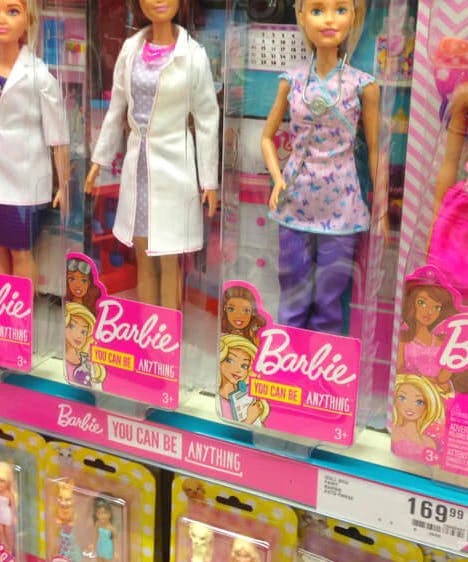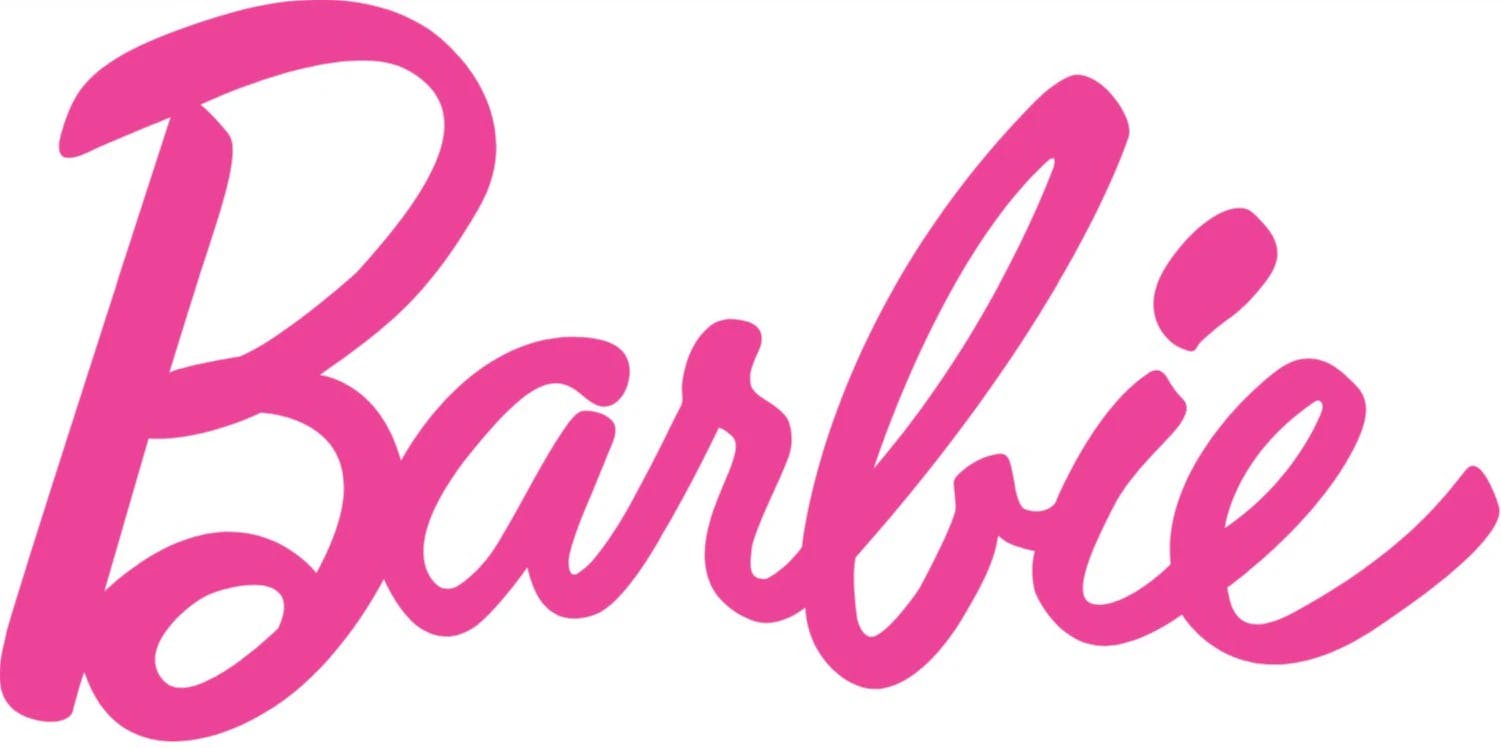The Pretty (And Ugly) Politics Behind Your Favorite Colors: Mattel Pink
Come on, Barbie, let’s go party!

Who really champions the color pink? Is it Victoria’s Secret with their Pink brand, providing young women with cloyingly sweet body sprays, five for $30 undergarment deals, and logo-ridden loungewear? How about luxury brand Valentino, with its hot pink hues that have recently swept runways and red carpet events alike?
Knowing that color is one of the most important marketing tools, as it sets apart iconic brands from imitators, the world’s chief capitalist proprietor of the color pink is undoubtedly Mattel. As the parent company of Barbie, Mattel has created a global stranglehold on this pretty pigment. Barbie not only benefits from over 99% brand awareness worldwide, but she is also historically the most popular fashion doll ever produced. The brand has blossomed into product lines in over 45 categories from clothing, to fitness, to food and more.
Mattel’s impeccable branding using its Pantone 219C Barbie Pink gives it extra value in the eyes of consumers. Something that remarkable requires special treatment, which is why you might face legal battles if you try to profit off its oh-so-pretty pink.
Enter the Hyper-Pink Daydream
Over 100 categories of Mattel products have a monopoly on the usage of what we know as Barbie pink. The signature color, Pantone 219C or hex code #DA1884, is a bright pink that was likely chosen to attract young girls to the Barbie brand. However, when Barbie first emerged on the scene in the 1950s, she didn’t actually don her now-standard shade.
Barbie was originally developed as a high-fashion doll, so her first outfit was a black-and-white striped swimsuit. When Mattel Creations founders Elliot and Ruth Handler created her logo in 1959, they did use the first iteration of the Barbie Pink we know and love today. Though the logo has now had five major redesigns, each design has used some shade of Barbie pink. In 1975, the logo shifted more toward a hot pink, while in 1991 it was lighter, and subsequent designs have been more saturated.

Barbie logo originally from the 1959 launch. Public domain, via Wikimedia Commons.
Nearly every product you pick up has a symbol on it that looks like ™ or ®. These are proof that something has been trademarked, a protective element of intellectual property, or IP. A company, like Mattel, can establish that something (like their signature Barbie pink) is its intellectual property. Trademarks can also protect the intellectual property of words, phrases, designs, or symbols that the company uses to identify or promote its product or service.
For Mattel, that particular Pantone 219C shade is trademarked, but interestingly enough, the phrase “Barbie pink” is no longer trademarked. As of May 10, 2010, trademark registries have reported that “BARBIE PINK,” assigned Serial Number #77442813 by the U.S. Patent and Trademark Office, is currently abandoned with no statement of use filed. Perhaps the name isn’t off-limits, but the color – similar to Tiffany & Co.'s grasp on Tiffany Blue – is a protected element of Mattel.
It’s not so simple making sure your signature shade can be protected by trademark law, however. First, your color of choice must distinguish your brand and not be used by similar brands within your industry space. For reference, when Cheerios tried to trademark their shade of yellow, it was denied because other cereal brands use similar yellows (if not the same one) and the yellow itself wasn’t yet distinctive enough to consumers.
Next, the color you’re hoping to trademark can’t have functional purposes. Pepto-Bismol tried to trademark its pink, but because the court noted the “therapeutic value” for treating upset stomachs, competitors in the market should be allowed to use the shade of pink if they’re offering, say, a generic version of the product.
Don’t Get on Her Bad Side, She’s Legally Blonde
Part and parcel of owning a trademark is dealing with legal drama to protect your intellectual property. Mattel faced its biggest battle for its branding when, in 1997, Danish pop group Aqua released their hit song “Barbie Girl.” Distributed by MCA Records, “Barbie Girl” was available to listeners on a bright pink CD and, for a moment, was even marketed at Toys ‘R’ Us using a “Barbie Girl” purse which was heart-shaped and – you guessed it – pink.
Mattel filed a lawsuit, asserting that the recording infringed on its trademark and diluted Barbie’s value. After all, the lyrics do include a line poking fun at the Barbie character, saying, “I’m a blonde bimbo girl in a fantasy world.” While Mattel was unhappy with the way it thought consumers might assume it backed this song and even went so far as to say it was a “crime,” MCA sued Mattel for defamation.
Ultimately, Aqua’s song was deemed protected free speech. Judge Alex Kozinski pointed out that the Barbie trademark had become an integral part of the public’s vocabulary, using a similar example of people saying “Band-Aid” when they really meant a quick fix. The judge likened Barbie to a staple word in our language and also pointed out that the trademark wasn’t diluted because the song was a parody on the Barbie image.
More recently, Mattel leveraged a lawsuit against Rap Snacks, which released Barbie-Que potato chips inspired by Nicki Minaj. The honey truffle flavored chips used Mattel’s pink color on its packaging because Minaj has called herself Barbie and her fans the Barbz. Mattel stated that Rap Snacks didn’t ask for permission in advance or issue a correction once notified of its infringement, but just a month after the case was filed, the multinational toy company dropped the suit.
Barbie Is Having a Cultural Moment
Perhaps a consequence of our increasingly maximalist shift in culture, Barbiecore – driven by variations of Mattel’s pink color – is taking over red carpets, fashion weeks, mainstream consumer goods, and more. Hollywood, switching up its seemingly standard remake formula, is now leaning into product adaptations as cinematic content. We’re getting Mario on the big screen this spring, and Barbie is set to grace movie theaters nationwide in the summer.
Directed by Greta Gerwig (after having been dropped by Amy Schumer, who claimed to be too busy), the Barbie movie starring Margot Robbie and Ryan Gosling has revived widespread love for bright pink hues. Now, Pantone’s 2023 Color of the Year is Viva Magenta (18-750), and KitchenAid’s 2023 Color of the Year is a similar bright, matte fuchsia called Hibiscus.
It’s audacious, spirited, and vibrant, a transition away from the more muted, delicate choices of Veri Peri from 2022 (Pantone 17-3938) and Ultimate Gray or Illuminating from 2021 (Pantone 17-5104 and Pantone 13-0647). This Barbiecore color grabs the attention of onlookers and signals Y2K glitz and glamor reminiscent of early-aughts Paris Hilton.
Though the shade is arguably much more vivid and eye-catching, Valentino’s flirty pink color is also contributing to the recent Barbiecore craze. Designer Pier Paolo Piccioli released the Valentino Fall 2022 collection last March at Paris Fashion Week, which only featured pink and black apparel.
Then, at the Valentino Haute Couture show in July 2022, Anne Hathaway took to Milan streets in a pink sequin dress that quickly went viral. Barbiecore has since continued to rise in popularity.
At New York Fashion Week this past February, Kelsea Ballerini wore a high-slit Carolina Herrera dress that channeled Barbie glam.
When Kacey Musgraves arrived on the 2023 Grammys red carpet, her bubblegum pink bodysuit, matching pumps, and feathered, floor-length cape of the same shade made a major statement.
Jessica Chastain donned an off-the-shoulder hot pink ensemble while recently attending the 2023 SAG Awards.
Bottom line: Whether bold or tastefully subdued, Barbiecore is now the “it girl” aesthetic of the year, and the pink that Mattel set as the doll’s standard may be to blame.
Closing Thoughts
Last year, mainstream publications insisted that Barbiecore pink was the hottest summer trend, but with Greta Gerwig’s Barbie set for a summer blockbuster release, I’m predicting now that we’ll not only be seeing Viva Magenta, but Viva Mattel Pink everywhere. We’re clamoring for escapism as a response to an economic downturn. This is answered by the whimsy of doll-like fantasies that Barbiecore brings center stage, evoked by on-brand, hyper-feminine pink hues.
Don’t miss anything! Sign up for our weekly newsletter and get curated content weekly!